+ Open data
Open data
- Basic information
Basic information
| Entry | Database: PDB / ID: 2cau | ||||||
|---|---|---|---|---|---|---|---|
| Title | CANAVALIN FROM JACK BEAN | ||||||
 Components Components | PROTEIN (CANAVALIN) | ||||||
 Keywords Keywords | PLANT PROTEIN / VICILIN / 7S SEED PROTEIN / DOMAIN DUPLICATION / SWISS ROLL | ||||||
| Function / homology |  Function and homology information Function and homology informationnutrient reservoir activity / protein-containing complex / identical protein binding Similarity search - Function | ||||||
| Biological species |  | ||||||
| Method |  X-RAY DIFFRACTION / X-RAY DIFFRACTION /  MOLECULAR REPLACEMENT / Resolution: 2.1 Å MOLECULAR REPLACEMENT / Resolution: 2.1 Å | ||||||
 Authors Authors | Ko, T.-P. / Day, J. / Macpherson, A. | ||||||
 Citation Citation |  Journal: Acta Crystallogr.,Sect.D / Year: 2000 Journal: Acta Crystallogr.,Sect.D / Year: 2000Title: The refined structure of canavalin from jack bean in two crystal forms at 2.1 and 2.0 A resolution. Authors: Ko, T.P. / Day, J. / McPherson, A. #1:  Journal: Acta Crystallogr.,Sect.D / Year: 1993 Journal: Acta Crystallogr.,Sect.D / Year: 1993Title: Determination of Three Crystal Structures of Canavalin by Molecular Replacement Authors: Ko, T.-P. / Ng, J.D. / Day, J. / Greenwood, A. / Macpherson, A. | ||||||
| History |
|
- Structure visualization
Structure visualization
| Structure viewer | Molecule:  Molmil Molmil Jmol/JSmol Jmol/JSmol |
|---|
- Downloads & links
Downloads & links
- Download
Download
| PDBx/mmCIF format |  2cau.cif.gz 2cau.cif.gz | 84.3 KB | Display |  PDBx/mmCIF format PDBx/mmCIF format |
|---|---|---|---|---|
| PDB format |  pdb2cau.ent.gz pdb2cau.ent.gz | 62.4 KB | Display |  PDB format PDB format |
| PDBx/mmJSON format |  2cau.json.gz 2cau.json.gz | Tree view |  PDBx/mmJSON format PDBx/mmJSON format | |
| Others |  Other downloads Other downloads |
-Validation report
| Summary document |  2cau_validation.pdf.gz 2cau_validation.pdf.gz | 374.7 KB | Display |  wwPDB validaton report wwPDB validaton report |
|---|---|---|---|---|
| Full document |  2cau_full_validation.pdf.gz 2cau_full_validation.pdf.gz | 381 KB | Display | |
| Data in XML |  2cau_validation.xml.gz 2cau_validation.xml.gz | 8.5 KB | Display | |
| Data in CIF |  2cau_validation.cif.gz 2cau_validation.cif.gz | 13 KB | Display | |
| Arichive directory |  https://data.pdbj.org/pub/pdb/validation_reports/ca/2cau https://data.pdbj.org/pub/pdb/validation_reports/ca/2cau ftp://data.pdbj.org/pub/pdb/validation_reports/ca/2cau ftp://data.pdbj.org/pub/pdb/validation_reports/ca/2cau | HTTPS FTP |
-Related structure data
| Related structure data |  2cavC 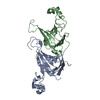 1cavS S: Starting model for refinement C: citing same article ( |
|---|---|
| Similar structure data |
- Links
Links
- Assembly
Assembly
| Deposited unit | 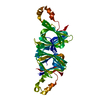
| ||||||||||||
|---|---|---|---|---|---|---|---|---|---|---|---|---|---|
| 1 | 
| ||||||||||||
| Unit cell |
| ||||||||||||
| Components on special symmetry positions |
|
- Components
Components
| #1: Protein | Mass: 50383.469 Da / Num. of mol.: 1 / Source method: isolated from a natural source / Details: TREATED WITH LIMITED DIGESTION BY TRYPSIN / Source: (natural)   Keywords: TREATED WITH LIMITED DIGESTION BY TRYPSIN / References: UniProt: P50477 Keywords: TREATED WITH LIMITED DIGESTION BY TRYPSIN / References: UniProt: P50477 |
|---|---|
| #2: Water | ChemComp-HOH / |
-Experimental details
-Experiment
| Experiment | Method:  X-RAY DIFFRACTION / Number of used crystals: 1 X-RAY DIFFRACTION / Number of used crystals: 1 |
|---|
- Sample preparation
Sample preparation
| Crystal | Density Matthews: 2.3 Å3/Da / Density % sol: 46 % / Description: REFERENCE TO PDB1CAU | ||||||||||||||||||||||||
|---|---|---|---|---|---|---|---|---|---|---|---|---|---|---|---|---|---|---|---|---|---|---|---|---|---|
| Crystal grow | pH: 6.8 Details: THIS CRYSTAL FORM COULD BE GROWN ONLY OCCASIONALLY. BASICALLY IT WAS CRYSTALLIZED FROM PURIFIED PROTEIN AFTER TRYPSIN TREATMENT IN PHOSPHATE BUFFERED SALINE, BUT WAS DIFFICULT TO REPRODUCE., pH 6.8 | ||||||||||||||||||||||||
| Crystal grow | *PLUS Temperature: 277-281 K / Method: vapor diffusion | ||||||||||||||||||||||||
| Components of the solutions | *PLUS
|
-Data collection
| Diffraction | Mean temperature: 291 K |
|---|---|
| Diffraction source | Source:  ROTATING ANODE / Type: RIGAKU RU200 / Wavelength: 1.5418 ROTATING ANODE / Type: RIGAKU RU200 / Wavelength: 1.5418 |
| Detector | Type: SDMS / Detector: AREA DETECTOR |
| Radiation | Monochromator: GRAPHITE CRYSTAL / Protocol: SINGLE WAVELENGTH / Monochromatic (M) / Laue (L): M / Scattering type: x-ray |
| Radiation wavelength | Wavelength: 1.5418 Å / Relative weight: 1 |
| Reflection | Resolution: 2.02→40 Å / Num. obs: 22331 / % possible obs: 85.5 % / Redundancy: 3.2 % / Rmerge(I) obs: 0.048 / Net I/σ(I): 21 |
| Reflection shell | Resolution: 2.02→2.18 Å / Redundancy: 1.7 % / Rmerge(I) obs: 0.184 / Mean I/σ(I) obs: 3 / % possible all: 66.5 |
| Reflection | *PLUS Num. measured all: 71863 |
| Reflection shell | *PLUS % possible obs: 66.5 % / Num. unique obs: 3415 / Num. measured obs: 5944 |
- Processing
Processing
| Software |
| ||||||||||||||||||||||||||||||||||||||||||||||||||||||||||||||||||||||||||||||||
|---|---|---|---|---|---|---|---|---|---|---|---|---|---|---|---|---|---|---|---|---|---|---|---|---|---|---|---|---|---|---|---|---|---|---|---|---|---|---|---|---|---|---|---|---|---|---|---|---|---|---|---|---|---|---|---|---|---|---|---|---|---|---|---|---|---|---|---|---|---|---|---|---|---|---|---|---|---|---|---|---|---|
| Refinement | Method to determine structure:  MOLECULAR REPLACEMENT MOLECULAR REPLACEMENTStarting model: PDB ENTRY 1CAV Resolution: 2.1→40 Å / Data cutoff high absF: 10000000 / Data cutoff low absF: 0.001 / Isotropic thermal model: RESTRAINED / Cross valid method: THROUGHOUT / σ(F): 2
| ||||||||||||||||||||||||||||||||||||||||||||||||||||||||||||||||||||||||||||||||
| Displacement parameters | Biso mean: 28.3 Å2 | ||||||||||||||||||||||||||||||||||||||||||||||||||||||||||||||||||||||||||||||||
| Refine analyze |
| ||||||||||||||||||||||||||||||||||||||||||||||||||||||||||||||||||||||||||||||||
| Refinement step | Cycle: LAST / Resolution: 2.1→40 Å
| ||||||||||||||||||||||||||||||||||||||||||||||||||||||||||||||||||||||||||||||||
| Refine LS restraints |
| ||||||||||||||||||||||||||||||||||||||||||||||||||||||||||||||||||||||||||||||||
| LS refinement shell | Resolution: 2.1→2.2 Å / Total num. of bins used: 8
| ||||||||||||||||||||||||||||||||||||||||||||||||||||||||||||||||||||||||||||||||
| Xplor file |
| ||||||||||||||||||||||||||||||||||||||||||||||||||||||||||||||||||||||||||||||||
| Software | *PLUS Name:  X-PLOR / Version: 3.8 / Classification: refinement X-PLOR / Version: 3.8 / Classification: refinement | ||||||||||||||||||||||||||||||||||||||||||||||||||||||||||||||||||||||||||||||||
| Refinement | *PLUS Highest resolution: 2.1 Å / Lowest resolution: 40 Å / σ(F): 2 / % reflection Rfree: 8 % / Rfactor obs: 0.175 | ||||||||||||||||||||||||||||||||||||||||||||||||||||||||||||||||||||||||||||||||
| Solvent computation | *PLUS | ||||||||||||||||||||||||||||||||||||||||||||||||||||||||||||||||||||||||||||||||
| Displacement parameters | *PLUS Biso mean: 28.3 Å2 | ||||||||||||||||||||||||||||||||||||||||||||||||||||||||||||||||||||||||||||||||
| Refine LS restraints | *PLUS
| ||||||||||||||||||||||||||||||||||||||||||||||||||||||||||||||||||||||||||||||||
| LS refinement shell | *PLUS Rfactor Rfree: 0.291 / % reflection Rfree: 6.2 % / Rfactor Rwork: 0.239 / Rfactor obs: 0.239 |
 Movie
Movie Controller
Controller




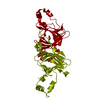
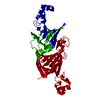

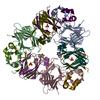
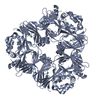



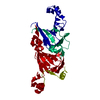
 PDBj
PDBj
